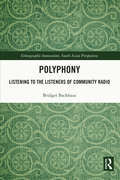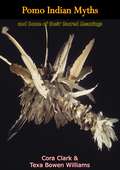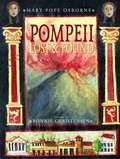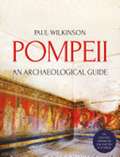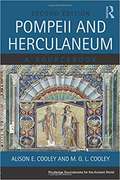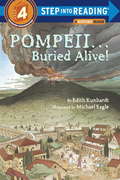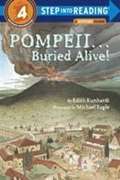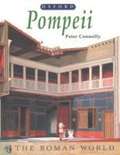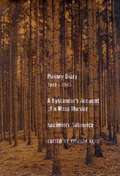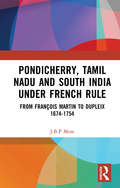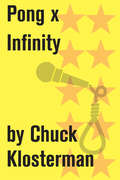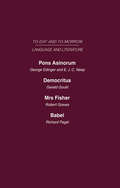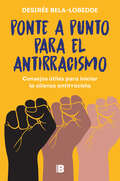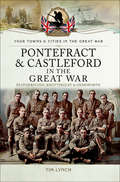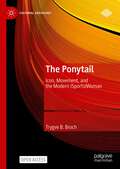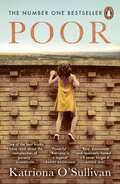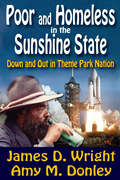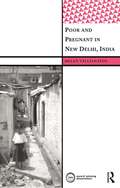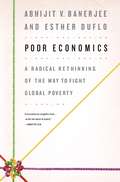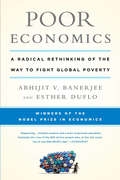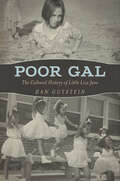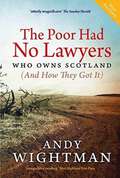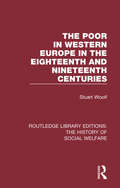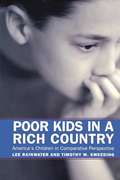- Table View
- List View
Polyphony: Listening to the Listeners of Community Radio (Ethnographic Innovations, South Asian Perspectives)
by Bridget BackhausThis book looks at the rich and complex history of broadcasting and community broadcasting in the multicultural and multilingual milieu in India. It explores the world of community radio and how community radio broadcasters hear and speak to their audiences under the overarching theme of polyphony. The book discusses the socio-historical contexts which allowed community radio to thrive in India. It highlights its potential to create alternative spaces of representation, and opportunity and its importance in preserving and disseminating local knowledge and traditions. The author weaves together ethnographic research and literature, as well as personal narratives and stories of those involved in the field. Further, the monograph critically examines the impact of development agendas on community projects and processes, discussing in detail the pervasiveness of the development discourse in every aspect of community radio and how it manifests on air. It also illustrates the limitations of community radio, within the context of its participation in the “spectacle of development”. Accessible and deeply insightful, this book will be of interest to researchers and students of cultural studies, sociology, social anthropology, media and communication studies, and South Asian studies.
Pomo Indian Myths and Some of their Sacred Meanings
by Cora Clark Texa Bowen WilliamsIn this volume, which was first published in 1954, some forty-odd myths collected at various Pomo settlements are given clearly and concisely by Cora Clark and Texa Bowen Williams. It includes a separate section in which the sister authors provide a partial analysis of the myths based upon the interpretations given them by the storytellers. The meanings attributed to the tales include much nature symbolism: coyote, in an abbreviated creation myth, for example, is said to represent earth; Frog Woman, water; Kingfisher, air; and the Lizard, fire. In other tales, the number four is said to represent the growth principle; arrows, heat rays; and so on. This type of symbolism has not been attributed to the Pomo in previous discussions, and is thus represented here for the first time. A fascinating addition to the literature on Pomo mythology!
Pompeii: Lost and Found
by Mary Pope OsborneA lively history of the eruption of Mount Vesuvius in AD 70, which changed the world of one of the richest towns in the Roman Empire, Pompeii.
Pompeii: An Archaeological Guide
by Paul WilkinsonThe resonant ruins of Pompeii are perhaps the most direct route back to the living, breathing world of the ancient Romans. Two million visitors annually now walk the paved streets which re-emerged, miraculously preserved, from their layers of volcanic ash. Yet for all the fame and unique importance of the site, there is a surprising lack of a handy archaeological guide in English to reveal and explain its public spaces and private residences. This compact and user-friendly handbook, written by an expert in the field, helpfully fills that gap. Illustrated throughout with maps, plans, diagrams and other images, Pompeii: An Archaeological Guide offers a general introduction to the doomed city followed by an authoritative summary and survey of the buildings, artefacts and paintings themselves. The result is an unrivalled picture, derived from an intimate knowledge of Roman archaeology around the Bay of Naples, of the forum, temples, brothels, bath-houses, bakeries, gymnasia, amphitheatre, necropolis and other site buildings - including perennial favourites like the House of the Faun, named after its celebrated dancing satyr.
Pompeii and Herculaneum: A Sourcebook (Routledge Sourcebooks For The Ancient World Series)
by Alison E. Cooley M.G.L. Cooley<P>The original edition of Pompeii: A Sourcebook was a crucial resource for students of the site. Now updated to include material from Herculaneum, the neighbouring town also buried in the eruption of Vesuvius, Pompeii and Herculaneum: A Sourcebook allows readers to form a richer and more diverse picture of urban life on the Bay of Naples. <P>Focusing upon inscriptions and ancient texts, it translates and sets into context a representative sample of the huge range of source material uncovered in these towns. From the labels on wine jars to scribbled insults, and from advertisements for gladiatorial contests to love poetry, the individual chapters explore the early history of Pompeii and Herculaneum, their destruction, leisure pursuits, politics, commerce, religion, the family and society. Information about Pompeii and Herculaneum from authors based in Rome is included, but the great majority of sources come from the cities themselves, written by their ordinary inhabitants – men and women, citizens and slaves. <P>Encorporating the latest research and finds from the two cities and enhanced with more photographs, maps, and plans, Pompeii and Herculaneum: A Sourcebook offers an invaluable resource for anyone studying or visiting the sites.
Pompeii...Buried Alive! (Step into Reading)
by Edith Kunhardt DavisIllus. in full color. "The drama of natural disasters provides prime material to entice young independent readers. In this volume, the account of the eruption of Mount Vesuvius describes village life 2,000 years ago, the eruption itself and its aftermath, and the excitement when the buried town is rediscovered centuries later. A lively and factual glimpse of a devastating moment in history, in an accessible, attractive package."--Publishers Weekly.
Pompeii (The Roman World)
by Peter ConnollyFrom the remarkable pen of Peter Connolly comes a comprehensive look at the ancient city of Pompeii. He begins with the scientific facts: How was Pompeii destroyed? How did Mount Vesuvius become an active volcano? What happened during the eruption? How long did Pompeii lay buried and how was it finally rediscovered? What was Pompeii's history before the disaster? Then, Peter Connolly does what he does better than anyone--he rebuilds the past in words and pictures, allowing us to imagine what it was like to live in old Pompeii. Like an archaeological detective, he sifts through the ruins and artifacts to reconstruct one area of the town in minute detail. With maps and cross-sections, photographs, drawings, and engrossing, fact-filled text, Connolly takes us into the very homes of its citizens--into the kitchens, atriums, bedrooms and out into the gardens. We learn what the furniture looked like, how the homes were lighted and heated, what kind of jewelry was popular, and what the gladiators wore. We view the varied styles of architecture and decoration, attend a grand dinner party, visit local shops, go to the theater, to a public bath, and to the gladiators' arena. We gain an understanding of this ancient civilization, and begin to see how much was lost when the city fell prey to the tons of lava and ashes that fell on it during the devastating disaster.
Ponary Diary, 1941-1943: A Bystander's Account of a Mass Murder
by Kazimierz Sakowicz Yitzhak Arad Laurence WeinbaumAbout sixty thousand Jews from Wilno (Vilnius, Jewish Vilna) and surrounding townships in present-day Lithuania were murdered by the Nazis and their Lithuanian collaborators in huge pits on the outskirts of Ponary. Over a period of several years, Kazimierz Sakowicz, a Polish journalist who lived in the village of Ponary, was an eyewitness to the murder of these Jews as well as to the murders of thousands of non-Jews on an almost daily basis. He chronicled these events in a diary that he kept at great personal risk. Written as a simple account of what Sakowicz witnessed, the diary is devoid of personal involvement or identification with the victims. It is thus a unique document: testimony from a bystander, an "objective" observer without an emotional or a political agenda, to the extermination of the Jews of the city known as "the Jerusalem of Lithuania. "Sakowicz did not survive the war, but much of his diary did. Painstakingly pieced together by Rahel Margolis from scraps of paper hidden in various locations, the diary was published in Polish in 1999. It is here published in English for the first time, extensively annotated by Yitzhak Arad to guide readers through the events at Ponary.
Pondicherry, Tamil Nadu and South India under French Rule: From François Martin to Dupleix 1674-1754
by J.B.P. MoreThis is a study of the colonization of Pondicherry, Tamil Nadu and South India by the French during the eighteenth century, and their interactions with the Indian rulers and populations in the political, economic, social and religious spheres. French Governors based in Pondicherry since François Martin up to Dupleix never acquired any territory for France through outright conquest. They or their masters in France never had any grand plan to establish a French empire in India. Some Indian rulers were friendly with the French and the English as it served their interests. The study demonstrates that the French colonizers and missionaries would not have survived in India without the collaboration of the Indian dubashes, merchants, certain Indian rulers and military men.This collaboration was not on an equal footing, as the sepoys, merchants and dubashes were always subordinate and submissive to the Europeans. Even Ananda Ranga Poullé, the most famous of the Indian dubashes had to resort to the art of flattery to be in the good books of his ‘master’. European arrival and presence in India heralded the beginning of a cultural clash between the Europeans and Indians, in which the former had the upper hand. There was never any partnership or ‘master-bania’ relationship between the French and the Indians. Instead, the relationship had all the trappings of a ‘master-subordinate’ relationship, where the subordinate even though he might be a dubash was always at the mercy of the colonizers. The element of force, aggressivity and violence was omnipresent in European presence and expansion in India, in the political, economic and religious fields.Please note: This title is co-published with X. Taylor & Francis does not sell or distribute the Hardback in India, Pakistan, Nepal, Bhutan, Bangladesh and Sri Lanka.
Pong x Infinity
by Chuck KlostermanOriginally collected in Chuck Klosterman IV and now available both as a stand-alone essay and in the ebook collection Chuck Klosterman on Media and Culture, this essay is about video games.
Pons Asinorum, or the Future of Nonsense Democritus or the Future of Laughter Mrs Fisher or the Future of Humour, Babel, or the Past, Present and Future of Human Speech: Today and Tomorrow Volume Twenty-Two
by Edinger, Gould, Graves, PagetPons Asinorum Or The Future of Nonsense George Edinger and E J C Neep Originally published in 1929. "A most entertaining essay, rich in quotation from the old masters of clownship’s craft." Saturday Review The author maintains that true nonsense must be aimless humour – the humour that makes fun as opposed to the humour that makes fun of something. 88pp Democritus Or The Future of Laughter Gerald Gould Originally published in 1929. "Democritus is bound to be among the favourites of the series. Gould’s humour glances at history, morality, and humanity…wise and witty writing." Observer Democritus is intended to illustrate the prevailing fashion in laughter and on the basis of historical and philosophical principles to forecast the humour of the future. 90pp Mrs Fisher Or The Future of Humour Robert Graves Originally published in 1928 "Mr Graves is the best man who could have been chosen to write on this subject." Daily Express "…perfectly irresponsible, as a joker should be." The Times This volume analyzes humour with a solemnity which becomes almost nightmarish. 90pp Babel Or the Past, Present and Future of Human Speech Richard Paget Originally published in 1930. "…stimulating and absorbing." Journal of Education This volume discusses human speech and treats it as a growth which must be tamed if it is to fulfil its highest purpose as a symbolism for human thought. 86pp
Ponte a punto para el antirracismo: Consejos útiles para iniciar la alianza antirracista
by Desirée Bela-LobeddeNo basta con no ser racista: hay que ser antirracista ¿Qué es la supremacía y el privilegio blanco? ¿Existe un racismo institucional? ¿Cómo nombramos y nos comunicamos con los demás? ¿Cuál es el problema de la apropiación cultural? ¿España es racista? ¿Yo soy racista? ¿Cómo se puede contribuir a cambiar el paradigma? Este libro es una guía fundamental hacia la educación antirracista. A través de apuntes teóricos e históricos, reflexiones, consejos y ejercicios para analizar nuestros comportamientos, la activista Desirée Bela-Lobedde -autora de Ser mujer negra en España y Minorías- recoge los principios básicos del antirracismo y nos invita a poner en marcha de manera práctica alternativas para contribuir activamente a un cambio real. «Para que el racismo desaparezca, y si queremos que desaparezca de verdad, hay que tener la educación necesaria que nos permita mirar con ojos críticos la raíz del sistema que genera esas desigualdades, y analizar cómo, con nuestras acciones, contribuimos a su perpetuación o a su desmantelamiento».
Ponteach, or the Savages of America
by Tiffany PotterPontiac, or Ponteach, was a Native American leader who made war upon the British in what became known as Pontiac's Rebellion (1763 to 1766). One of the earliest accounts of Pontiac is a play, written in 1766 by the famous frontier soldier Robert Rogers, of the Rangers. Ponteach, or the Savages of America is one of the only early dramatic works composed by an author with personal knowledge of the Indigenous nations of North America. Important both as a literary work and as a historical document, Ponteach interrogates eighteenth-century Europe's widespread ideological constructions of Indigenous peoples as either innocent and noble savages, or monstrous and violent Others.Presented for the first time in a fully annotated edition, Ponteach takes on questions of nationalism, religion, race, cultural identity, gender, and sexuality; the play offers a unique perspective on the Rebellion and on the emergence of Canadian and American identities. Tiffany Potter's edition is supplemented by an introduction that critically and contextually frames the play, as well as by important appendices, including Rogers' ethnographic accounts of the Great Lakes nations.
Pontefract & Castleford in the Great War: Featherstone, Knottingley & Hemsworth (Your Towns & Cities in the Great War)
by Timothy LynchBy the end of 1914, 15,000 Yorkshire miners had volunteered for the army, with around 1,000 from a single Castleford pit. Over the next four years these courageous men would write home from the killing fields of France, Gallipoli, Italy, Mesopotamia and Africa. As the men marched away, the families they left behind were about to experience a war that reached into every home, touching every man, woman and child in the country. This was total war.Local women some still teenage girls faced the gruelling hardships and dangers of munitions work. Some would die for their country. Former male pupils at the Quaker school struggled with their consciences. Some would fight, some would serve in the front lines as ambulance men and others would go to prison for their beliefs. Using original material, diaries, letters and newspaper reports, this enthralling book tells the fascinating and largely forgotten story of the Great War at home. Covering the terror of Zeppelin raids and anti-German rioting, foreign refugees, a story of true love among the gentry, the vexed question of whether bookies were essential war workers and tales of heroism at the front, here is the war as experienced by the dedicated people of Pontefract and Castleford.
The Ponytail: Icon, Movement, and the Modern (Sports)Woman (Cultural Sociology)
by Trygve B. BrochThis open access book adopts a cultural sociology of materiality to explore the hallmark of the female athlete: the ponytail. Studying a wealth of news articles about ponytails in sports and society, Broch uncovers this hairstyle’s polyvocality and argues that it is a total social phenomenon. By separating his approach from the cultural studies tradition, Broch highlights how hair is imbued with codes, narratives, and myth that allow its wearers to understand, maneuver, and criticize social gender relations in deeply personal ways. Using multiple theories about hair, bodies, myths, and icons, he creates a multidimensional method to show how icons are imitated and used. As women navigate their practical lives, health issues, and gendered expectations, the ponytail materializes their dynamic maneuvering of cultural and social environments. Sporting a ponytail—itself an embodiment of movement—is filled with a performativity of social movements: a cultural kinetics that is never apolitical.
Poor: Grit, courage, and the life-changing value of self-belief
by Katriona O'SullivanThe No. 1 BestsellerBiography of the Year, Irish Book Awards 2023The Last Word Listeners' Choice Award, Irish Book Awards 2023'One of the best [books] I have read about the complexities of poverty . . . one of the most remarkable people you will ever meet' GuardianLike young girls everywhere Katriona O’Sullivan grew up bright, enthusiastic, curious. But she was also surrounded by abject poverty and chaos, and after she became pregnant and homeless at 15, what followed was five years of barely surviving. Yet today Katriona is an award-winning academic whose work explores barriers to education for girls like her.What set Katriona on this unexpected path were the mentors and supporters who truly saw her. The teachers who showed her how to wash in the school toilets or turned up at her door to convince her to sit at least one GCSE. The community worker who encouraged her to apply for training schemes. The friend who introduced Katriona to Trinity College’s access program while she was a cleaner. Simple acts that would help her turn her life around.Told with warmth, clarity and compassion – compassion for her parents, for her younger self, for others – Poor is both an astonishing personal testimony and an impassioned plea for the future of our children.‘Powerful – Katriona is a legend’ Barry Keoghan‘Raw, passionate and resolutely honest – I’ll never forget it’ Annie Mac'Full of insight . . . so important' Fi Glover, Times Radio 'I read poor in one sitting I found it so compelling . . . moving, uplifting, brave, heroic' Nuala McGovern, Woman's Hour, BBC Radio Four'Moving, funny, brave and original - just like the author . . . absolutely incredible' Roísín Ingle, Irish Times Women's Podcast‘One of the books of the year’ Patrick Kielty, Late Late Show, RTÉ One'One of the most important books I have ever read … a beautiful telling of determination despite the odds' Lynn Ruane, Irish Times 'Fearless, funny and searingly honest' Adil Ray OBE'Raw and remarkable' Irish Independent 'A book of empowerment and hope' Patricia Scanlan‘Remarkable . . . a vivid retelling of Katriona flourishing, despite her beginnings’ BBC News West MidlandsNumber 1 bestseller, Irish Times, March 2024
Poor and Homeless in the Sunshine State: Down and Out in Theme Park Nation
by James WrightA place like Orlando, Florida is not transformed from swampland to sprawling metropolis through Peter Pan-like flights of fancy, but through theme park expansions requiring developmental schemes that are tough minded and often worsen relationships between the wealthy and the poor. The homeless arrive with their own hopes and illusions, which are soon shattered. The rest of the local population makes its peace with the system. Meanwhile the homeless are reduced to advocacy models that neither middle- nor working-class folks much worry about. They are modern members of Ellison's "invisible men" but they comprise a racial and social mixture unlike any other in the American landscape.This book is primarily about the dark side of this portrait the poor, near-poor, homeless, and dispossessed who live in the midst of this verdant landscape. The phrase "down and out," has been used to describe people who are destitute or penniless since the late nineteenth century. Here the term is used in a more expansive sense, as synonymous with anyone who lives near, at, or over the edge of financial catastrophe.
Poor and Pregnant in New Delhi, India (International Institute for Qualitative Methodology Series)
by Helen VallianatosIn this innovative contribution to the study of food, gender, and power, Helen Vallianatos meticulously documents cultural values and beliefs, dietary practaices, and the nutritional and health status of mothers in Indian squatter settlements. She explores both large-scale forces—incorporating critical medical anthropology and feminist theory into a biocultural paradigm—and the local and individual choices New Delhi women make in interpreting cultural dietary norms based on their reproductive histories, socioeconomic status, family structure, and other specific conditions. Her findings have significant implications for nutritional and medical anthropology and development studies, and her innovative research design serves as a model for multi-method studies that use participatory research principles, combine quantitative and qualitative investigations, and interpret diverse types of data.
Poor Economics
by Abhijit Banerjee Esther DufloWinner of the 2011Financial Times/Goldman Sachs Best Business Book of the Year Award Billions of government dollars, and thousands of charitable organizations and NGOs, are dedicated to helping the world's poor. But much of their work is based on assumptions that are untested generalizations at best, harmful misperceptions at worst. Abhijit Banerjee and Esther Duflo have pioneered the use of randomized control trials in development economics. Work based on these principles, supervised by the Poverty Action Lab, is being carried out in dozens of countries. Drawing on this and their 15 years of research from Chile to India, Kenya to Indonesia, they have identified wholly new aspects of the behavior of poor people, their needs, and the way that aid or financial investment can affect their lives. Their work defies certain presumptions: that microfinance is a cure-all, that schooling equals learning, that poverty at the level of 99 cents a day is just a more extreme version of the experience any of us have when our income falls uncomfortably low. This important book illuminates how the poor live, and offers all of us an opportunity to think of a world beyond poverty. Learn more at www. pooreconomics. com
Poor Economics: A Radical Rethinking of the Way to Fight Global Poverty
by Abhijit V. Banerjee Esther DufloThe winners of the Nobel Prize in Economics upend the most common assumptions about how economics works in this gripping and disruptive portrait of how poor people actually live. Why do the poor borrow to save? Why do they miss out on free life-saving immunizations, but pay for unnecessary drugs? In Poor Economics, Abhijit V. Banerjee and Esther Duflo, two award-winning MIT professors, answer these questions based on years of field research from around the world. Called "marvelous, rewarding" by the Wall Street Journal, the book offers a radical rethinking of the economics of poverty and an intimate view of life on 99 cents a day. Poor Economics shows that creating a world without poverty begins with understanding the daily decisions facing the poor.
Poor Gal: The Cultural History of Little Liza Jane (American Made Music Series)
by Dan GutsteinPoor Gal: The Cultural History of Little Liza Jane chronicles the origins and evolution of a folk tune beloved by millions worldwide. Dan Gutstein delves into the trajectory of the “Liza Jane” family of songs, including the most popular variant “Li’l Liza Jane.” Likely originating among enslaved people on southern plantations, the songs are still performed and recorded centuries later.Evidence for these tunes as part of the repertoire of enslaved people comes from the Works Progress Administration ex-slave narratives that detail a range of lyrics and performance rituals related to “Liza Jane.” Civil War soldiers and minstrel troupes eventually adopted certain variants, including “Goodbye Liza Jane.” This version of the song prospered in the racist environment of burnt cork minstrelsy. Other familiar variants, such as “Little Liza Jane,” likely remained fixed in folk tradition until early twentieth-century sheet music popularized the melody.New genres and a slate of stellar performers broadly adopted these folk songs, bringing the tunes to far-reaching listeners. In 1960, to an audience of more than thirty million viewers, Harry Belafonte performed “Little Liza Jane” on CBS. The song was featured on such popular radio shows as Fibber McGee & Molly; films such as Coquette; and a Mickey Mouse animation. Hundreds of recognizable performers—including Fats Domino, Bing Crosby, Nina Simone, Mississippi John Hurt, and Pete Seeger—embraced the “Liza Jane” family. David Bowie even released “Liza Jane” as his first single. Gutstein documents these famous renditions, as well as lesser-known characters integral to the song’s history. Drawing upon a host of cultural insights from experts—including Eileen Southern, Carl Sandburg, Thomas Talley, LeRoi Jones/Amiri Baraka, Charles Wolfe, Langston Hughes, and Alan Lomax—Gutstein charts the cross-cultural implications of a voyage unlike any other in the history of American folk music.
The Poor Had No Lawyers: Who Owns Scotland (and How They Got It)
by Andy WightmanIn this updated edition of his &“utterly magnificent&” social history, the Scottish parliamentarian examines the privatization of Scotland&’s common land (Sunday Herald, UK). As an author, activist, and politician, Andy Wightman has made a career of fighting for Scottish land reform. In this provocative and influential book, Wightman offers a revealing analysis of how and why landowners got their hands on the millions of acres that were once held in common. He also tells the untold story of how the Scottish legal and political establishment appropriated land through legal fixes. Throughout, Wightman poses some provocative questions: Have attempts to redistribute power made any difference? What are the implications of the debt-fueled housing bubble, the Smith Commission, and the new Scottish Government's proposals on land reform? Can we get our common good land back? For all those with an interest in urban and rural land in Scotland, this edition of The Poor Had No Lawyers, updated with new statistics, provides a fascinating analysis of one the most important political questions in Scotland.
The Poor in Western Europe in the Eighteenth and Nineteenth Centuries (Routledge Library Editions: The History of Social Welfare #25)
by Stuart WoolfFirst published in 1986, this book examines poverty and changing attitudes towards the poor and charity across England, France and Italy. It discusses the causes of poverty and the distinctions between the poor and the class-conscious proletariat. Taking early nineteenth-century Italy as a special study, it uses the exceptionally rich documentary sources from this time to examine such issues as charity, repression, the reasons why families suffered poverty and what strategies they adopted for survival. In this study, Stuart Woolf takes full account of recent work in historical demography and in sociological studies of poverty and the welfare state to produce this original and thoughtful work. This book will be of interest to those studying the history of poverty, class and the welfare state.
Poor Kids In A Rich Country: America's Children In Comparative Perspective
by Lee Rainwater Timothy M. SmeedingIn comparing the situation of American children in low-income families with their counterparts in other wealthy countries, Lee Rainwater and Timothy M. Smeeding provide a powerful perspective on the dynamics of child poverty in the United States.
